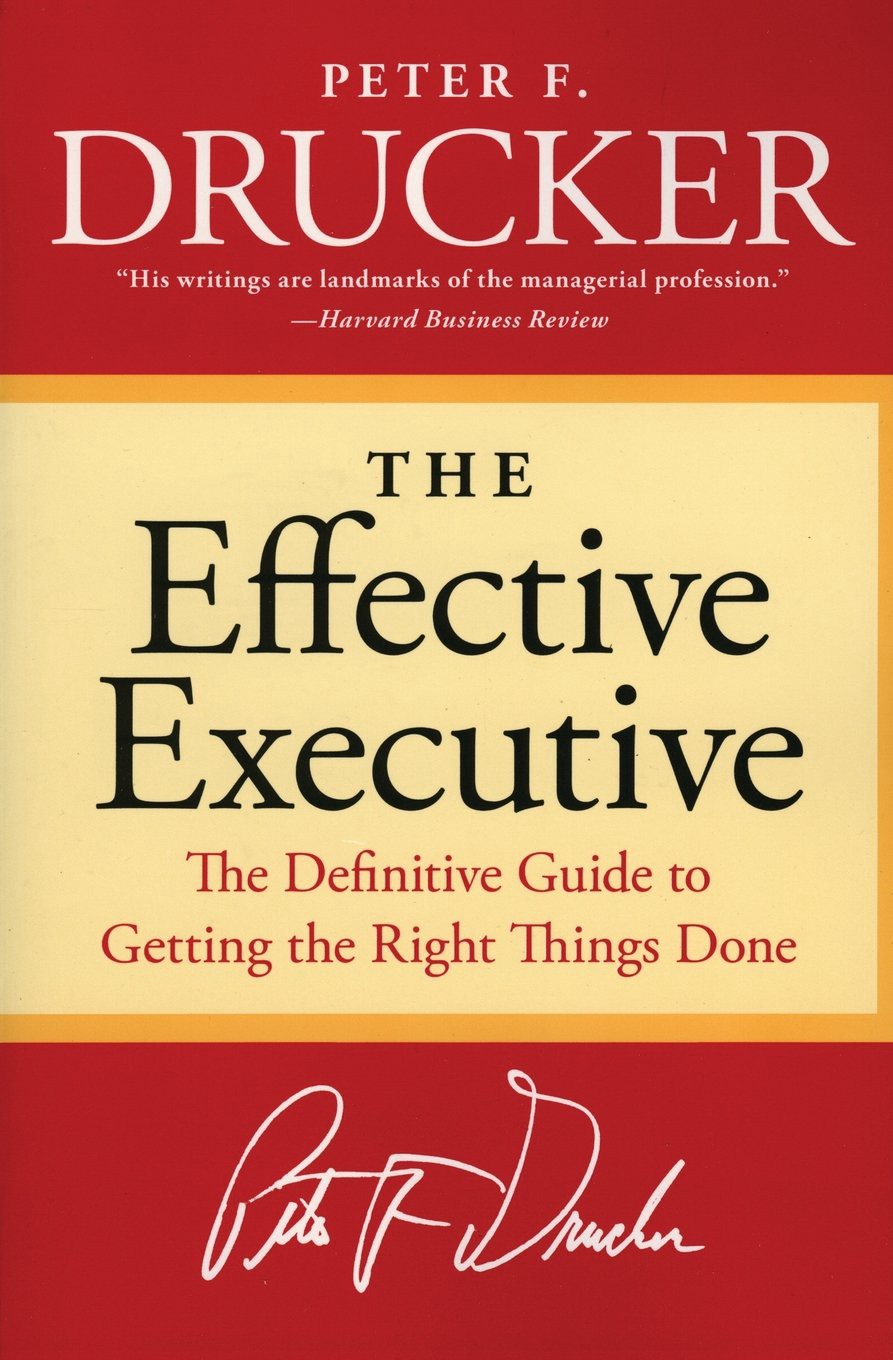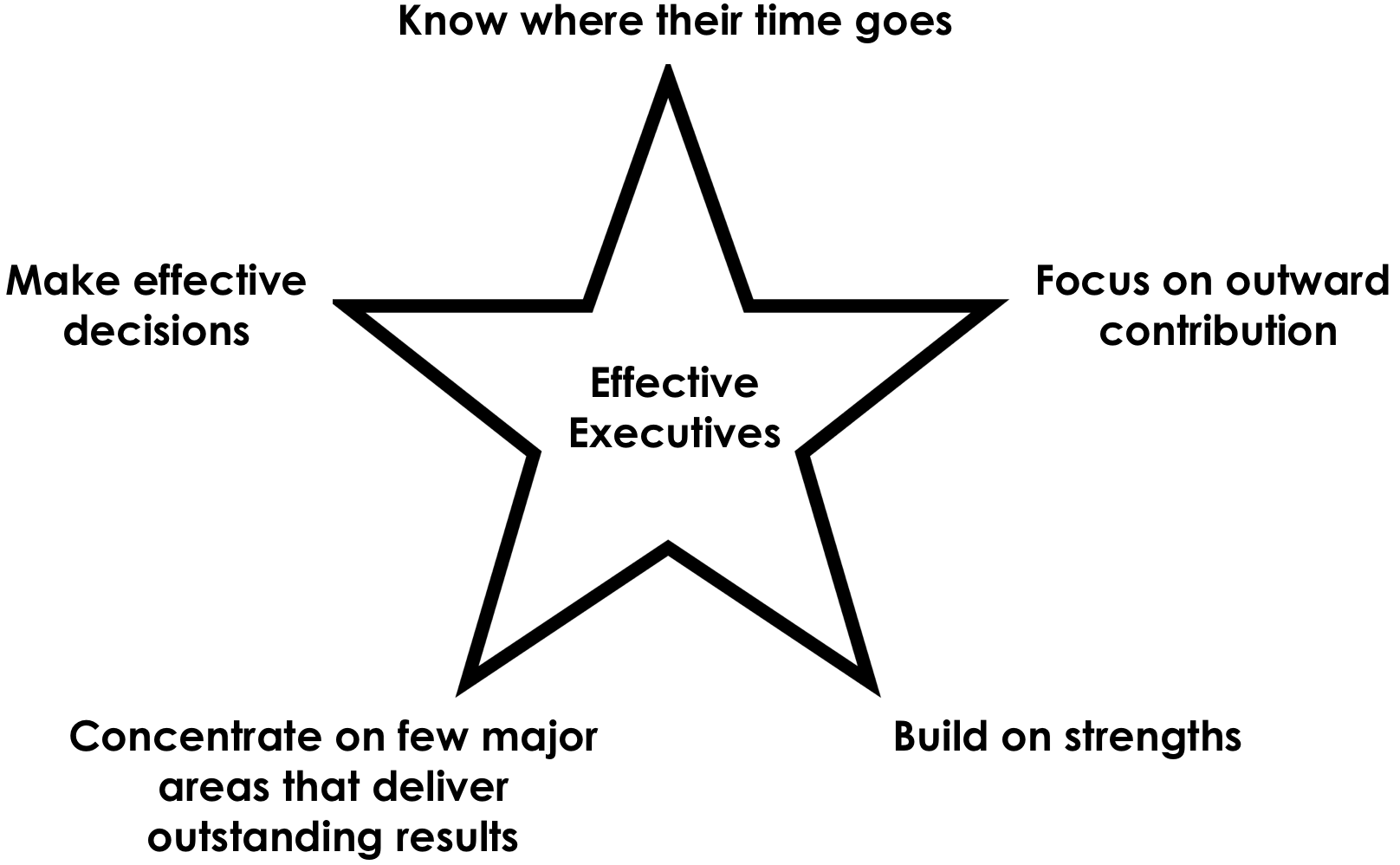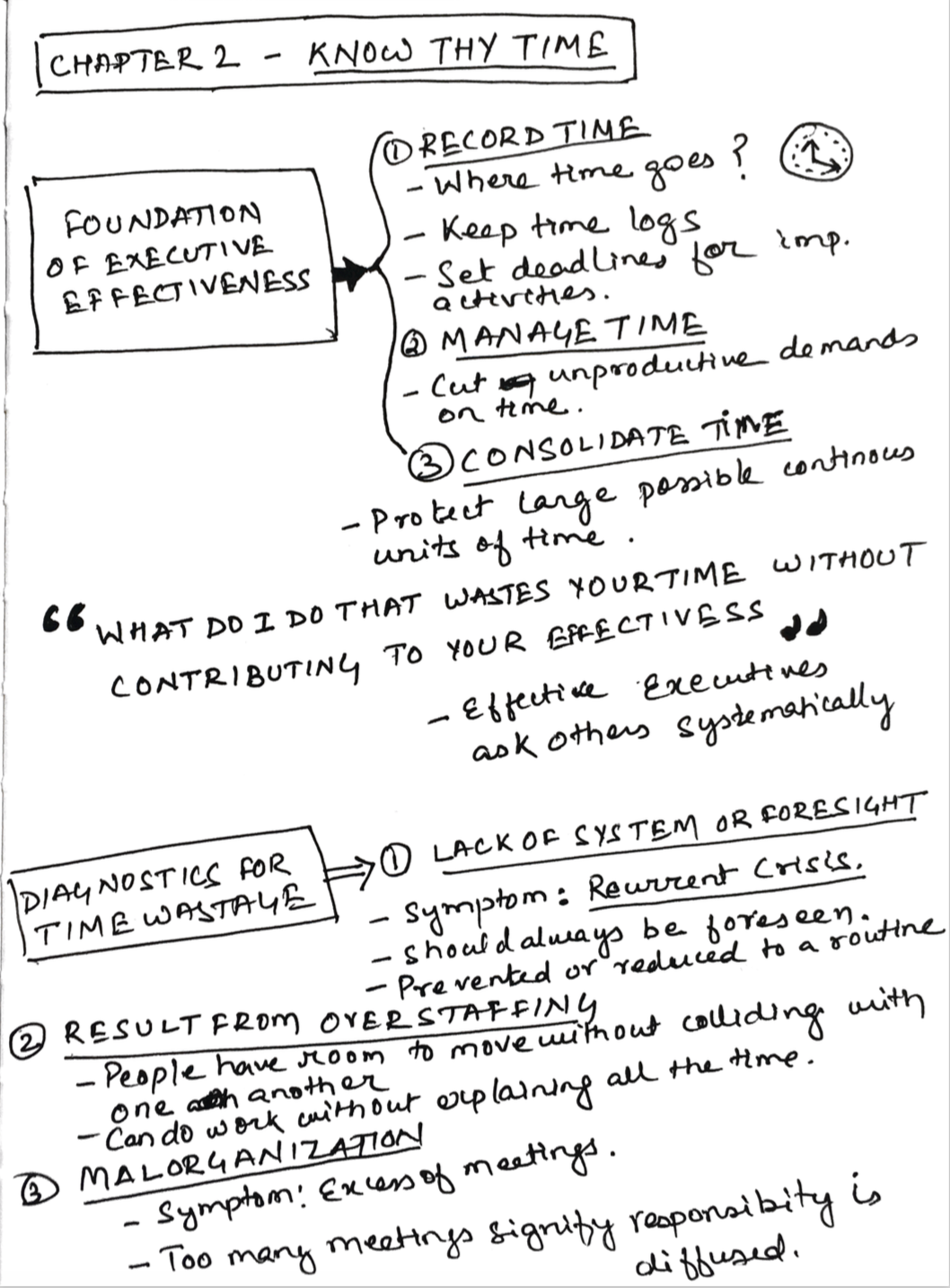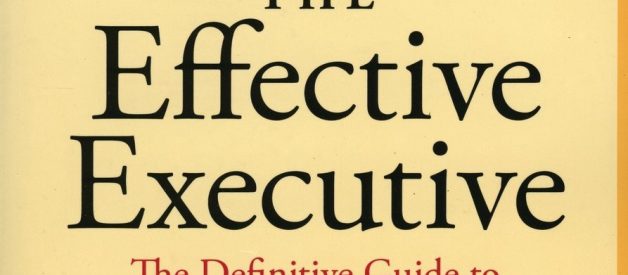Rating: 4/5

Goals Driven Life Newsletter
There are always a couple of things that you know you are great at. I know I am great at writing awesome inspirational?
eepurl.com
Peter Drucker?s book The Effective Executive was one of my top picks for 2018. I would recommend it strongly to all working professionals (knowledge workers as Peter calls them in the book) no matter where they are on the totem pole of their organization. I would not hesitate to say that if you apply the principles laid out in the book with discipline, this would elevate your effectiveness to many notches higher. I am going to revisit the book many times over in my career.
Hope you enjoy the summary:
The book has seven chapters:
- Effectiveness Can Be Learnt
- Know Thy Time
- What Can I Contribute?
- Making Strength Productive
- First Things First
- The Elements of Decison Making
- Effective Decisions
Chapter 1: Effectiveness Can Be Learnt
- The subject of the book is managing oneself for effectiveness.
- Executives who do not know how to make themselves effective in their own job and work set the wrong example.
- To be effective does not require special gifts, special aptitude or training.
- Effectiveness can be practiced till it becomes a habit.
- Without effectiveness there is no performance.
- Intelligence, imagination and knowledge are essential resources, but only effectiveness converts them to results.
Who is an executive?
- Every knowledge worker ? managers or individual professionals ? in modern organisation is an executive if they are expected by the virtue of their position or their knowledge to make decisions in the normal course of their work that have significant impact on the performance and results of the whole.
- He must take responsibility for his contribution.
- He is supposed, by virtue of his knowledge, to be better equipped to make the right decision than any one else.
- Knowledge work is not defined by quantity. Neither is defined by its costs. It is defined by its results.
There are five habits of the mind that have to be acquired to be an effective executive:
- Effective executives know where their time goes. They work systematically at managing the little of their time that can be brought under their control.
- Effective executives focus on outward contribution. They gear their results towards results rather than to work.
- Effective executives build on strengths ? their own strengths, the strengths of their superiors, colleagues and subordinates. They do not build on weakness. They do not start out with the things they cannot do.
- Effective executives concentrate on the few major areas where superior performance will produce outstanding results. They force themselves to set priorities and stay with their priority decisions. They know that they have no choice but to do first things first ? and second things not at all.
- Effective executives make effective decisions.

Chapter 2: Know Thy Time
- Effective executives do not start with their tasks. They start with their time. And they do not start out with planning. They start by finding out where their time actually goes.
- Then they manage their time by cutting back unproductive demands on their time.
- Finally they consolidate their time into largest possible continuous units.
- This three step process is the foundation of executive effectiveness: 1)Recording time 2)Managing time 3)Consolidating time.
- Executive effectives know time is the limiting factor. Unlike other resources, one cannot rent, hire, buy, or obtain more time.
- The effective executive knows that to manage his time, he first has to know where it actually goes.
- To be effective, each knowledge worker needs to be able to dispose off time in fairly large chunks. To have small dribs and drabs of time will not be sufficient even if total is an impressive number of hours.
- Since the knowledge worker directs himself, he must understand what achievement is expected of him and why.
- Wherever knowledge workers perform well in large organization, senior executives take time out, on a regular schedule, to sit down with them, sometimes all the way down to green juniors, and ask: ?What should we at the head of the organization know about your work? What do you want to tell me regarding the organization? Where do you see opportunities we do not exploit? Where do you see dangers to which we are still blind? What do you want to know from me about the organization?
- Without the above conversation from the management, the knowledge worker either lose enthusiasm and become time-servers, or they direct their energies toward their speciality and away from the opportunities and needs of the organization.
- ?Delegation? as a term is a misunderstanding. But getting rid of anything that can be done by somebody else so that one does not have to delegate but can really get to one?s own work ? that is a major improvement in effectiveness.
- Effective executives ask systematically ? ?What do I do that wastes your time without contributing to your effectivess??
- Meeting invitation template so that you dont waste everyone?s time ? ?I have asked Mr X and Y to meet with me on (X.X.XXX) in Room XYZ to discuss budget. Please come if you need the information or want to take part in the discussion. But you will in any event receive right away a full summary of the discussion and of any decisions reached, together with the request for your comments.?. In this invitation format, no one feels left out.
- There are three diagnostic questions to deal with unproductive and time-consuming activities that executives should ask:
- Time-wastes often result from overstaffing.
- There is a fairly reliable symptom of overstaffing. If the senior people in the group spend more than one-tenth of their time on problems of human relations, on feuds and frictions, on jurisdictional disputes, then the workforce is almost certainly too large.
- In a lean organization, people have room to move without colliding with one another, and can do the work without having to explain it all the time.
- The excuse for overstaffing is always the need for a specialist in the team just in case we need him. One should only have on a team the knowledges and skills that are needed day in day out for the bulk of the work. Specialists who are needed once in a while should always remain outside, and hired on contract.
2. Another common time-waster is malorganization.
- It?s symptom is an excess of meetings. We meet because people holding different jobs have to cooperate to get a specific task done. We meet because the knowledge and experience needed in a specific situation are not available in one head, but have to be pieced together out of the experience and knowledge of several people. Every meeting generates a host of little follow-up meetings ? some formal, some informal, but both stretching out for hours. Meetings therefore need to be purposefully directed. An undirected meeting is not just a nuisance, but a danger. Meetings have to be an exception rather than the rule.
- As a rule, meetings should never be allowed to become the main demand on an executive?s time.
- Too many meetings signify that work that should be in one job or one component is spread over several jobs or several components. They signify that the responsibility is diffused.
3. The last major time-waster is malfunction in information.
- Always be thoroughly prepared for meetings and do your homework.
- Senior executives rarely have as much as one quarter of their time truly at their disposal and available for the important matters, the matters that contribute, the matters they are being paid for.
- The higher up an executive, the larger will the proportion of his time that is not under his control and not spent on contribution. Therefore, the effective executive knows that he has to consolidate his discretionary time (the time that makes real contribution).
- He knows that he needs large chunks of time and small chunks are of no value at all.
- Some senior men work at home one day a week: a common method for time consolidation.
- Other people schedule all the operating work ? meetings, reviews, problem session ? for two days a week, and set aside mornings of the remaining days for consistent, containing work on major issues.
- Effective executives start by ESTIMATING how much discretionary time they can realistically call their own. Then they set aside continous time in the appropriate manner.
- All effective executives control their time management perpetually. They not only keep a continuing log and analyse it periodically, they set themselves deadlines for the important activities, based on their judgement and discretionary activities.

Chapter 3: What can I contribute?
- The effective executive focusses on contribution. He asks: ?What can I contribute that will significantly affect the performance and the results of the institution I serve??. His stress is on responsibility.
- A great majority of executives focus downward. They are occupied with efforts rather than with results. They worry about what the organization and their superiors owe them and should do for them.
- The man who focuses on efforts and and who stresses his downward authority, is a subordinate no matter how exalted his title and rank is. But the man who focuses on contribution and who takes responsibility for results, no matter how junior, is in the most literal sense, ?top management?.
- The executives who do not ask themselves, ?What can I contribute?? are not only likely to aim too low, they are likely to aim at the wrong things. They may define their contributions too narrowly.
- Every organization needs performance in three areas:
- It needs direct results: They play the role calories play in the nutrition of the human body.
- Building of values and their reaffirmation: They play a role of vitamins and minerals. There has to be something this organization stands for else it degenerates into disorganisation, confusion and paralysis.
- Building and developing people for tomorrow. :The organization therefore has to provide today the men who can run it tomorrow. It has to renew its human capital.
- All the above three have to built into the contribution of every executive.
- People adjust to the level of demands made on them. The executive who sets his sights on contribution, raises the sights and standards of everyone with whom he works.
- Commitment to contribution is commitment to responsible effectiveness. Without it, a man shortchanges itself, deprives his organisation, and cheats the people he works with.
The Right Human Relations
- Executives in an organization do not have good human relations because they have a ?talent for people?. They have good human relations because they focus on contribution in their own work and in their relationships for others.
The Effective Meeting
- The meeting, the report, or the presentation are the typical work situation of the executive. They are his specific, everyday tools. They also make great demands on his time.
- Effective executives know what they expect to get out of a meeting, a report, or a presentation and what the purpose of the meeting or presentation should be.
- They ask themselves, ?why are we having this meeting???Do we want a decision, or do we want to inform, or do we want to make clear to ourselves what we should be doing??
- They insist that the purpose be thought through and spelt out before a meeting is called.
- The effective executive always states at the outset of a meeting the specific purpose and contribution it is to achieve. He does not allow a meeting called to inform to degenerate into a brainstorming session in which everyone shares a bright idea.
- He always at the end of the meetings, goes back to the opening statement and relates the final conclusions to the original intent.
- The cardinal rule of the meeting is to focus from start on contribution.
- To focus on contribution is to focus on effectiveness.
- The focus on contribution by itself supplies the four basic requirements of effective human relations:
- Communications
- The harder the superior tries to say something to his subordinate, the more likely it is that the subordinate will mishear. He will hear what he expects to hear rather than what is being said.
- Effective executives who take responsibility for contribution in their own work will as a rule demand that their subordinates take responsibility too.
- The will ask their men: ?What are the contributions for which this organization should hold you accountable???What should we expect of you???What is the best utilisation of your knowledge and ability??. And then communication becomes easy.
- Once the subordinate has thought through what contribution is expected of him, the superior has both the right and the responsibility to to judge the validity of the contribution.
2. Teamwork
- The focus on contribution leads to communication sideways and thereby making teamwork possible. These people have to work together voluntarily and according to the logic of the situation and the demands of the task, rather than according to a formal jurisdictional structure.
3. Self-development
- The man who asks of himself, ?What is the most important contribution I can make to the performance of this organisation?? Asks in effect, ?What self-development do I need? What knowledge and skill do I need to acquire to make the contribution I should be making?? ?What standards do I have to set myself?? ?What strengths should I put to work??
4. Development of others
- The executive who focuses on contribution also stimulates others to develop themselves, whether they are subordinates, colleagues or superiors. He sets standards that are demands for excellence.They are demands for high aspiration, for ambitious goals, and for work of great impact.
- Knowledge workers grow according to the demands they make on themselves. The grow according to what they consider to be achievement and attainment. If they demand little of themselves, they will remain stunted. If they demand a good deal of themselves, they will grow to giant stature.
Chapter 4: Making strength productive
- The effective executive makes strength productive. He knows that one cannot build on weakness.
- To achieve results, one has to use all the available strengths ? the strengths of associates, the strengths of the superior, and one?s own strengths. These strengths are the true opportunities.
- These strengths can make the weaknesses irrelevant.
- The effective executive does not make staffing decisions based on minimising weakness but to maximise strength.
- Whoever tries to staff an organization to avoid weakness will end up at best with mediocrity. Strong people always have strong weakness too.
- Human excellence can only be achieved in one area, or at most in a very few.
- To focus on what there is not and to focus on weakness is wasteful.
- Achievement must be measured against objective criteria of contribution and performance. This is possible only if jobs are defined and structured impersonally. Otherwise in no time, personnel decisions will be made on ?Do I like this fellow?? Or ?Will he be acceptable?? Rather than by asking ?Is he the man most likely to do an outstanding job??
- Structuring jobs to fit personality is almost certain to lead to favouritism and conformity. No organization can afford either. It needs equity and impersonal fairness in its personnel decisions. Or else it will lose its good people.
- The men who build first class executive teams are not usually close to their immediate colleagues and subordinates. Picking people for what they can do rather than on personal likes and dislikes, they seek performance, not conformance. To insure this outcome, they keep a distance between themselves and their close colleagues.
How do effective executives staff for strength ?
- The effective executive first makes sure that the job is well designed. And if experience tells him otherwise, he does not hunt for genius to do the impossible. He redesigns the job. He knows that the test of the organization is not genius. It is its capacity to make common people achieve uncommon performance.
- The effective executive knows that to get strength one has to put up with weaknesses.
- The effective executive will ask: ?Does this man have strength in one major area? And this strength relevant to the task? If he achieves excellence in this one area, will it make a significant difference? And if the answer is ?yes?, he will go ahead and appoint the man.
- It must be an unbreakable rule to promote the man who by the test of performance is best qualified for the job to be filled.
- Conversely, it is the duty of the executive to remove ruthlessly anyone, especially a manager, who consistently fails to perform with high distinction. To let such a man stay corrupts the others.
- A superior has responsibility for the work of others. He also has power over the careers of others. Making strengths productive is much more than essential of effectiveness. It is a moral imperative, a responsibility of authority and position. ?
- To focus on weakness is not only foolish, it is irresponsible.
- A superior owes it to his organisation, to make the strength of everyone of his subordinates as productive as it can be.
- Organization must serve the individual to achieve through his strengths and regardless of his limitations and weakness.
How do I manage my boss?
- The effective executive tries to make fully productive the strengths of his superior.
- Making the strength of the boss productive is a key to the subordinate?s own effectiveness.
- The effective executive accepts that the boss is human and has his strengths and limitations.
- Effective executives does not worry too much over what the boss cannot do. He therefore asks: ?What can my boss do really well?? ?What has he done really well?? ?What does he need to know to use his strength???What does he need to get from me to perform??
Chapter 5: First things first:
- The one secret of effectiveness is concentration.
- Effective executives do first things first and they do one thing at a time.
- The need to concentrate is grounded in the nature of the executive?s job.
- The more an executive works at making strengths productive, the more will he become conscious of the need to concentrate on major opportunities. This is the only way to get results.
- The more one can concentrate time, effort and resources, the greater the number of diversity and tasks one can actually perform.
- The executive who wants to be effective and who wants his organization to be effective polices all programs, all activities, all tasks. He always asks: ?Is it still worth doing??And if it isn?t, he gets rid of it so as to be able to concentrate on the few tasks that if done with excellence will make a difference.
- DuPont has been doing better than its competitors because it abandons a product or a process before it begins to decline.
- The need to slough off the outworn old to make possible the productive new is universal.
Priorities and Posteriorities
- Courage rather than analysis dictates the truly important rules for identifying priorities:
- Pick the future as against the past.
- Focus on opportunity rather than the problem.
- Choose your own direction rather than climb the bandwagon.
- Aim high, aim for something that will make a difference, rather than something that is safe and easy to do.
Chapter 6: The elements of decision making
- Decision making is one of the tasks of an executive.
- Effective executives, make effective decisions.
- Effective executives, do not make a great many decisions. They concentrate on the important ones.
- They try to make the few important decisions on the highest level of conceptual understanding.
- They want impact rather than technique. They want to be sound rather than clever.
- Effective executives know when a decision has to be based upon principle and when it should be based upon the merits of the case and pragmatically.
- Unless a decision has ?degenerated into work? it is not a decision; it is at best a good intention.
The Five Elements of the Decision Process:
- The first question an effective decision maker asks : ?Is this a generic situation or an exception???Is this something that underlies a great many occurrences? Or is the occurrence a unique event that needs to be dealt as such? The generic always has to be answered through a rule, a principle.
- The decision process is Clear specifications as to what the decision has to accomplish. What are the objectives the decision has to reach? What are the minimum goals it has to attain? What are the conditions it has to satisfy- known as boundary conditions?
- The more concisely boundary conditions are stated, the greater the likelihood that the decisions will be effective.
- ?What is the minimum needed to resolve this problem?? Is the form in which boundary conditions are probed.
3. One has to start with what is right rather than what is acceptable- precisely because one always has to compromise at the end. But if one does not know what is right to satisfy the specifications and boundary conditions, one cannot distinguish between the right compromise and the wrong compromise.
4. Converting the decision into action is the fourth major element in the decision process. Decision will not become effective unless the action committments have been built into the decision from the start.
5. Finally, a feedback has to be built into a decision to provide a continuous testing, against actual events, of the expectations that underlie the decision. One needs reports and figures. But unless one builds one?s feedback around direct exposure to reality, one condemns oneself to a sterile dogmatism and with it to ineffectiveness.
Chapter 7: Effective Decisions
- A decision is a judgement. It is a choice between alternatives. It is rarely a choice between right and wrong.
- The effective executive knows that people do not start out with the search for facts. They start out with an opinion.
- People inevitably start out with an opinion: to ask them to search for facts first is even undesirable.
- The only rigorous method, the only one that enables us to test an opinion against reality, is based on the clear recognition that opinions came first-and that is the way it should be.
- The effective executive encourages opinions. He then asks: ?What would the facts have to be to make this opinion tenable??
- He insists that people who voice an opinion also take responsibility for defining what factual findings can be expected and should be looked for.
- The first rule of decision making is that one does not make a decision unless there is disagreement. Decisions are made well only if based on the clash of conflicting views, the dialogue between different points of view, the choice between different judgements.
- Effective executives are not ?intuitive? decision makers. They emphasise to test the opinions against facts.
- Everyone of the effective Presidents in American history had his own method of producing disagreement he needed in order to make an effective decision. Each created the disagreement he needed for some understanding of what the decision is all about.
- There are three main reasons for the insistence on disagreement:
- It is the only safeguard against the decision maker?s becoming the prisoner of the organisation. The only way to break out of the prison of preconceived notions is to make sure of argued, documented, thought ? through disagreements.
- Disagreements alone can provide alternatives to a decision. A decision without an alternative is a gamblers? throw.
- Disagreement is needed to stimulate the imagination.
- The effective executive uses conflict of opinion as a tool to make sure all major aspects of an important matter are looked at carefully.
- There is one final question the effective executive asks ? ?Is a decision really necessary?? One alternative is always the alternative of doing nothing. One has to make a decision when a condition is likely to degenerate if nothing is done.
- The great majority of decisions will lie between these extremes. The problem is not going to take care of itself; but it is unlikely to turn into degenerative malignancy. The opportunity is only for improvement rather than for real change and innovation; but it is still quite considerable. If we do not act, we will in all probability survive. But if we do act, we may be better off.
- In this situation, the effective decision maker compares effort and risk of action to risk of inaction.
- Guidelines:
- Act if on balance, the benefits greatly outweigh cost and risk;
- Act or do not act; but do not ?hedge? or compromise.
Conclusion : Effectivness must be learned
The book rests on two premises:
- The executive?s job is to be effective
- Effectiveness can be learnt
Effectiveness is not a ?subject?, but a self-discipline.
Steps:
- Recording where the time goes. If done with continuity, recording one?s time will nudge a man towards next steps for greater effectiveness.
- In this step, the executive disciplines himself to think through the reason why he is on payroll and the contribution he ought to make. The answers should lead to demands on himself for high standards. These questions ask the executive to assume responsibility rather than be satisfied if he ?pleases the boss?.
- Making strengths productive ? The executive integrates individual purpose and organization needs, individual capacity and organization results, individual achievement and organization opportunity.
- The effective decision is concerned with rational action. It requires both procedure and analysis, but its essence is an ethics of action.
Self development of the effective executive is central to the development of the organization. As executives work towards becoming effective, they raise the performance level of the whole organization.
Key takeaways from the book that I am going to apply to my own life and work:
- I promise to be more effective at work after reading this book. I want to take pride in being an effective executive.
- I am going to take stock of my weekly time from my calendar and create a report out of it. (Will update once I am done)
- I am going to block long continuous blobs of time on my calendar.
- I am going to ask for feedback frequently from my team mates and other people with whom I interact.
- I am going to use this meeting invitation format: ?I have asked Mr X and Y to meet with me on (X.X.XXX) in Room XYZ to discuss budget. Please come if you need the information or want to take part in the discussion. But you will in any event receive right away a full summary of the discussion and of any decisions reached, together with the request for your comments.?
- Will say ?no? to excess meetings. Will write another post on managing meetings.
- I will set myself deadlines for important activities.
- Have transparent conversation with my boss clearly listing out my key contributions that I should be accountable for and how my contribution should be measured. The contribution should be outcome based.
- I will ask myself before every week, ?What can I contribute to the organization?? And then write down the answer and review it by the end of the work. I will use OKRs as the format.
- I commit to always be purpose-driven for a meeting. I will always be well prepared and ready for all meetings. I will always focus on contribution for the meeting.
- I will always begin a meeting stating this upfront: ?Why are we having this meeting??. At the end of the meeting, I will again go back to the opening statement and summarize if we achieved the intent.
- I will always ask if a recurring meeting, a framework, a way of doing things has lived beyond its utility and promise.
- I will practice concentration and mindfulness at my work.
If you like this post, you may be interested in my email newsletter where I share summary book notes each month. You can unsubscribe any time.
 http://eepurl.com/gDjGOP
http://eepurl.com/gDjGOP


